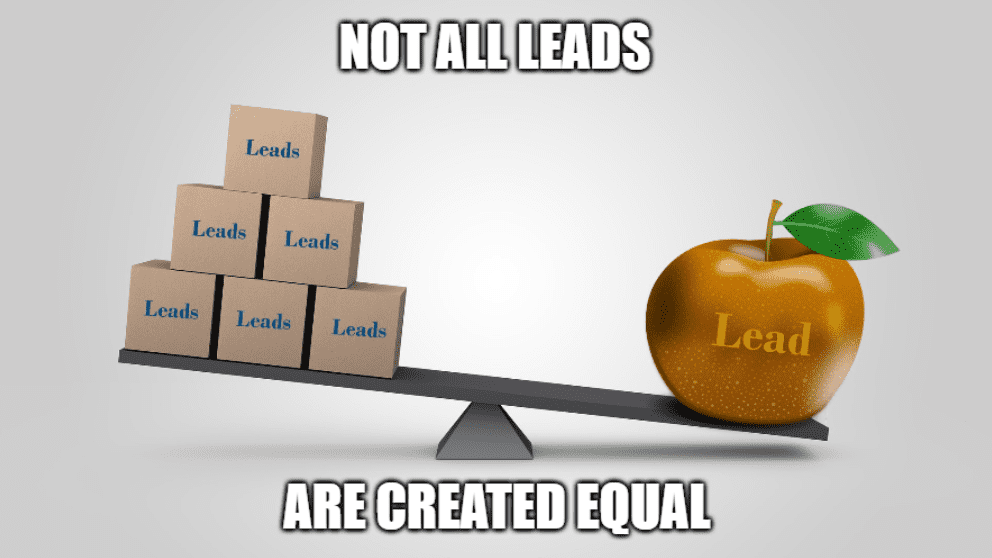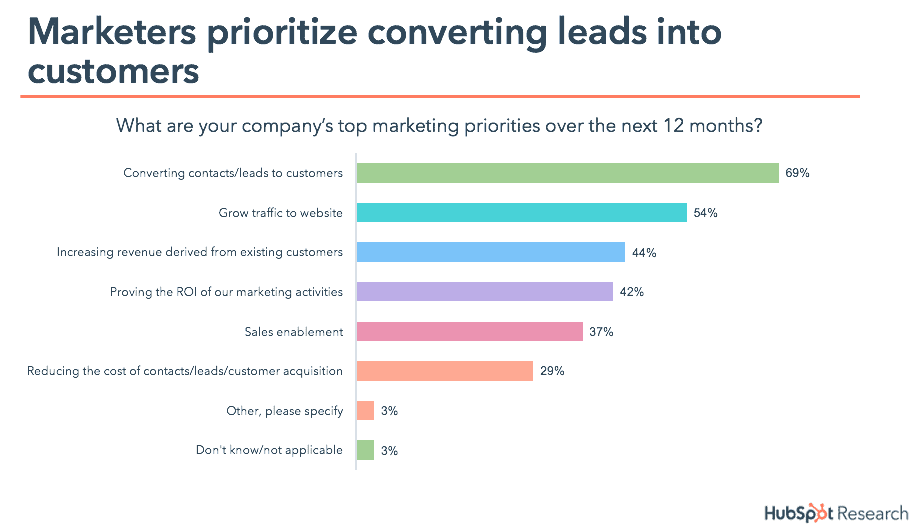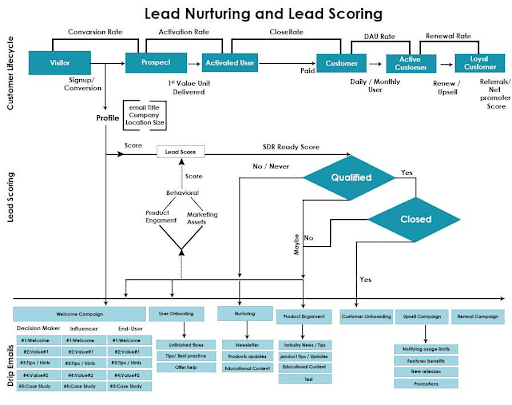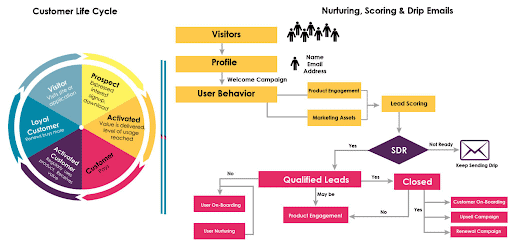Lead Scoring Tactics for Qualified Conversions
Podcast: Play in new window | Download
Subscribe Today RSS
Lead scoring can change the game of acquiring leads, and this week we're talking about lead scoring tactics that will allow you to focus your time on leads who are more likely to convert into actual customers.
This is a sort of sequel, or companion piece to our previous blog, which you can find here, for those that missed it:
Non-Linear Customer Journeys and How to Implement Them

Check out the video or podcast above. Subscribe to our weekly live stream on Facebook, or take it on the go with a podcast on your chosen platform. Keep up-to-date on news, trends, and tips in digital marketing and join in on the conversation.
What is Lead Scoring?
Lead scoring is the process of assigning each of your leads a score.
The score is based on who they are, how they interact with your business, and how likely they’re going to convert into a customer.
By reviewing your customers' past behaviours and other characteristics, you learn who your sales team should focus their efforts on.
Look at this graphic below for some interesting statistics on how lead scoring tactics can help grow your business.

As you can see, improvements are across the board, from streamlined sales processes to laser-focused marketing communications.
It isn’t enough to just build a massive email list and market to everyone.
You also have to make sure that your leads are qualified to purchase the product or service you’re offering.
This is where lead scoring can help.
Check out this excellent short video from Hubspot that's a great summary of the concept of lead scoring. Also, I frickin' love pinball.
Why Do You Need Lead Scoring Tactics?
Lead scoring pinpoints leads who are genuinely interested in your business’ product or service.
When you use lead scoring tactics to create your lead nurturing campaigns, it can help increase lead-to-customer conversion rates.
You can also determine which stage of your marketing funnel needs more nurturing.
That way, you can map your content properly, so they’ll convert more quickly.
Other benefits include shortening your sales cycle and increasing your business’ ROI.
Marketing Sherpa states that only 27% of the leads your marketing team hands over to your sales team are qualified leads.
This means that 73% of those leads are likely time wasted for your team.
The more qualified your leads are, the more efficient your team will be.
And you’ll save a ton of wasted time and money.

There's a reason why converting leads into customers is the #1 marketing priority of successful companies.
How Do You Set Up Lead Scoring?
There are some great tools out there that can make your lead scoring tactics a breeze to execute.
Really.
Sure, it can be some complex stuff, especially when you get into larger companies with multiple channels and touchpoints to track.
But with the right tools, any job can be made more manageable.
Here at Honeypot, we use Active Campaign - precisely because of the advanced automation toolsets they have available.
It's intuitive to use and a fantastic feature to have when setting up mail campaigns.
Mailchimp and Salesforce also have excellent tools that can help you set up lead scoring and are very popular in the industry.
Let's take a look at some examples to help illustrate the process.

In this example, Cindy is scored as an unqualified lead because she did not open the email sent to her.

In this example, Daniel opened the email, created an account, and downloaded a marketing template. Because he completed all of the actions, he is scored as a highly qualified lead.
As you can see from the two examples above, the framework for setting up lead scoring doesn't need to be complicated.
In these examples, we track 3 basic steps.
- Opening the email.
- Creating an account on Marketer Knows.
- Downloading a Marketing Template.
The third action could also be enrolling in a tutorial lesson, or any other action performed on the website.
By creating this flow, you're able to see what people are interested in, and where interest falls off.
You can then take all this data and refine your marketing message to these leads to align with the things they were showing the most interest in.
You can also segment the unqualified leads so you're not wasting time trying to sell to disinterested leads, which can save a boatload and time, effort, and money.
Advanced Lead Scoring Tactics
Depending on the size of the company and the number of touchpoints and advertising materials a prospect can engage with, lead scoring can become quite complex.
We won't dig too deeply into this right now, but let's take a look at what advanced lead scoring looks like.

This example shows the customer lifecycle with the company and the many channels and touchpoints the lead can engage with, including drip emails, social media, website and product engagement.
The above example goes far beyond the 3 basic touchpoints of the previous examples, by mapping out the entire customer lifecycle - detailing when to send drip emails, when to nurture the leads, and when to close the sale.

This example shows the customer life cycle and how they score along the flow chart at each stage of the life cycle.
Here is another example of a customer life cycle, showing the flow from a visitor to a loyal customer.
By scoring your leads, you'll be able to pinpoint when to nurture and guide them further along the funnel in their customer journey; this can ensure you don't jump too quickly to the sales pitch and lose your leads before they are ready to buy.
It can also help move cold leads further along the funnel by warming them up and nurturing them with valuable content that might help with their purchasing decision.
Tactics to Nurture, Educate, and Convert
So, what do you do if you have a bunch of low scoring leads? How do you warm up cold prospects into buying customers?
If you segment your leads into stages of cold, warm, and hot, you can focus on producing specific content for each stage.
When a prospect is cold, you'll want to focus on nurturing. You can do this by offering things like blog posts, FAQs, community invites, or introductory videos that give the prospect more information to help them make an informed decision.
Once the prospect has warmed up and is showing interest, you want to offer more educational content, such as product demos, webinar invites, and testimonials.
This will help enforce the value in your product or service, show the prospect how you can help with their pain points, and how other people have felt about their purchase or interaction with your brand.
The final stage is acting while the prospect is hot. This is where you want to pitch your sale, offer discounts, free consultations, or product bundles, depending on what the lead was showing interest in.
Here is a nice little visual that breaks down the 3 stages, with examples of what content works best in each stage.
Top 3 Takeaways
- Lead Scoring tells you which audiences are most likely to convert from lead to sale and where to focus your marketing and sales efforts the most.
- Review your lead flow process for large drop-offs, poor conversion rates, and opportunities to personalize marketing further.
- Work alongside your sales team to gain insights on lead quality and support the conversion to sale.
That's a Wrap
Getting started can sometimes be the most challenging part of lead scoring, since you can potentially have a ton of touchpoints to consider.
Once you're set up it will be much easier for your team to monitor, segment and evaluate your leads, allowing you to focus on the most qualified prospects.
This will save an enormous amount of wasted time and resources typically burned away chasing cold leads that will never convert.
We hope you found some value here and enjoyed the read, and as always, we'll leave you with some more resources to check out.
Thanks for reading!
Stay safe. Stay healthy.
Lead Scoring 101: How to Use Data to Calculate a Basic Lead Score - A comprehensive overview of lead scoring basics down the concept of lead scoring and the process for setting it up.
The Complete Guide to Lead Qualification Scoring - A great article that discusses the basic principles of lead scoring and understanding lead quality and value.
13 Lead Scoring Best Practices to Improve Lead Quality - Some great content with a ton of handy infographics and best practices to consider.
The Beginner’s Guide to Lead Scoring - As the title states, this is a beginner's guide to lead scoring that talks about creating buyer personas and what data points to score.
![]()



No comments yet.